Cloud Computing in Banking: Core Business, Security, and Benefits
VerifiedAdded on 2023/06/05
|7
|1871
|350
Report
AI Summary
This report provides an overview of cloud computing within the banking sector, focusing on the three core business areas offered by banks, the security and privacy needs related to banking services, and the ICT workload requirements including batch processing, transactional systems, and analytics. It examines the benefits of using cloud technologies in banking, such as cost reduction, improved flexibility, and auto-scalability, while also discussing the continued importance of mainframes in the banking industry due to their reliability, availability, and security features. The report concludes by emphasizing the balance between leveraging cloud computing for innovation and maintaining the robust security infrastructure provided by mainframes.
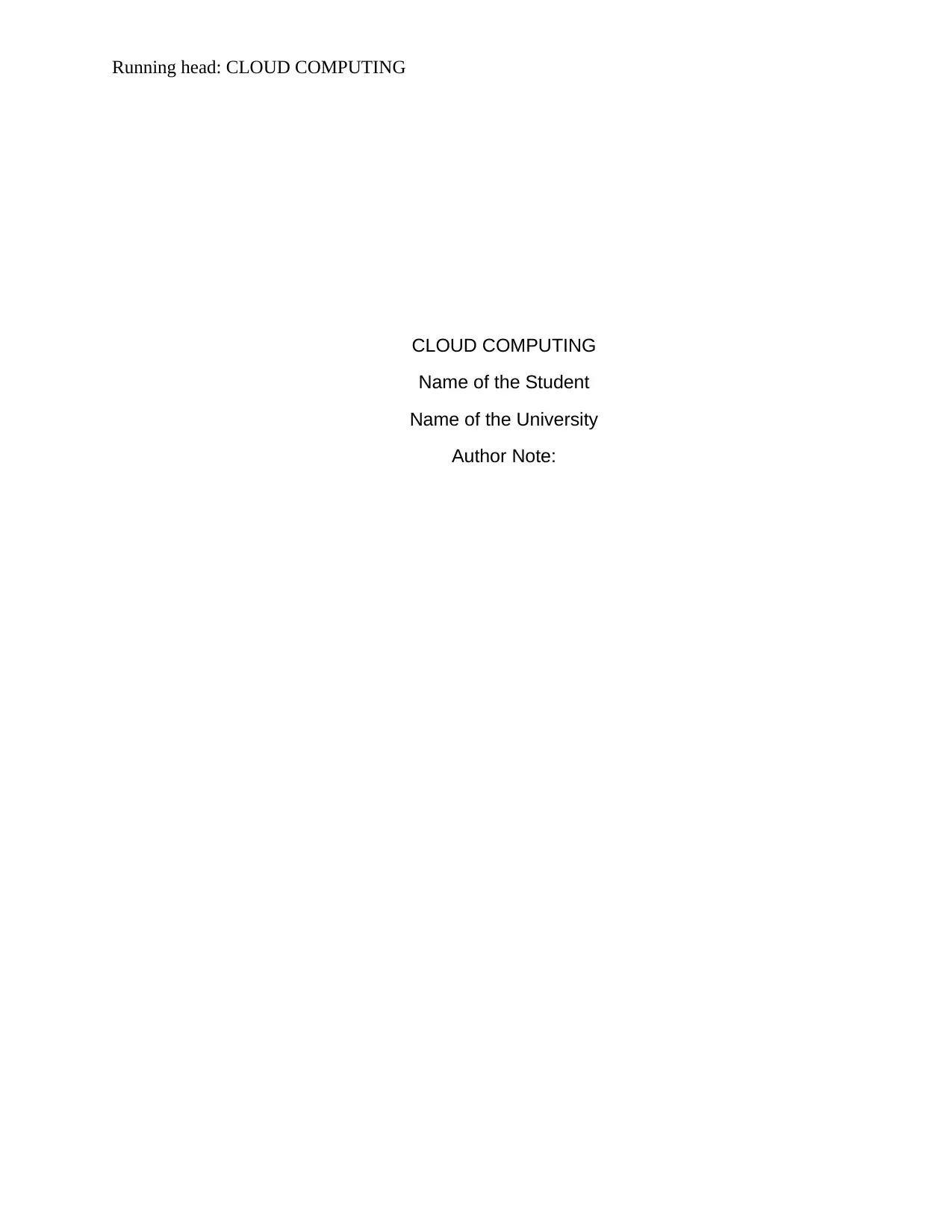
Running head: CLOUD COMPUTING
CLOUD COMPUTING
Name of the Student
Name of the University
Author Note:
CLOUD COMPUTING
Name of the Student
Name of the University
Author Note:
Paraphrase This Document
Need a fresh take? Get an instant paraphrase of this document with our AI Paraphraser
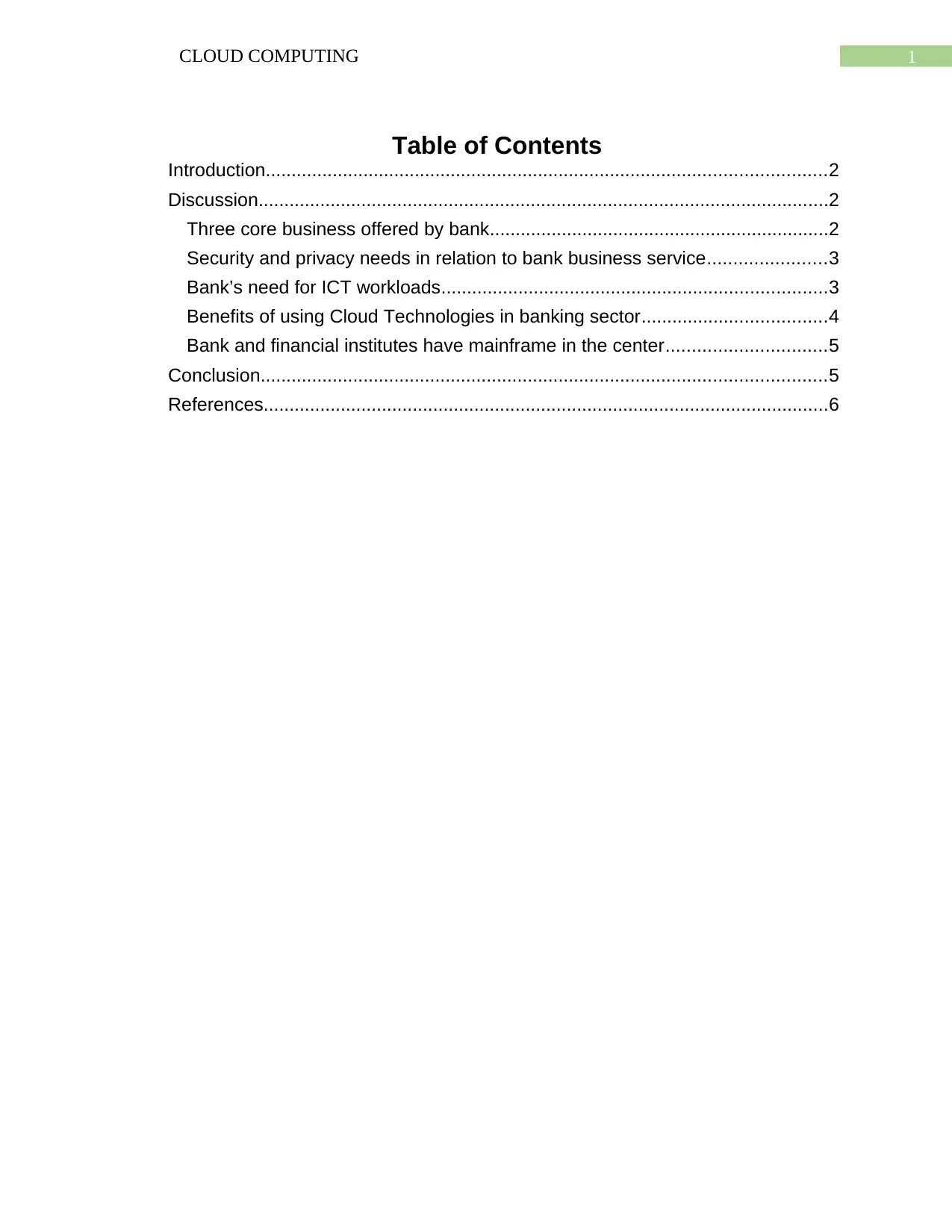
1CLOUD COMPUTING
Table of Contents
Introduction.............................................................................................................2
Discussion...............................................................................................................2
Three core business offered by bank..................................................................2
Security and privacy needs in relation to bank business service.......................3
Bank’s need for ICT workloads...........................................................................3
Benefits of using Cloud Technologies in banking sector....................................4
Bank and financial institutes have mainframe in the center...............................5
Conclusion..............................................................................................................5
References..............................................................................................................6
Table of Contents
Introduction.............................................................................................................2
Discussion...............................................................................................................2
Three core business offered by bank..................................................................2
Security and privacy needs in relation to bank business service.......................3
Bank’s need for ICT workloads...........................................................................3
Benefits of using Cloud Technologies in banking sector....................................4
Bank and financial institutes have mainframe in the center...............................5
Conclusion..............................................................................................................5
References..............................................................................................................6
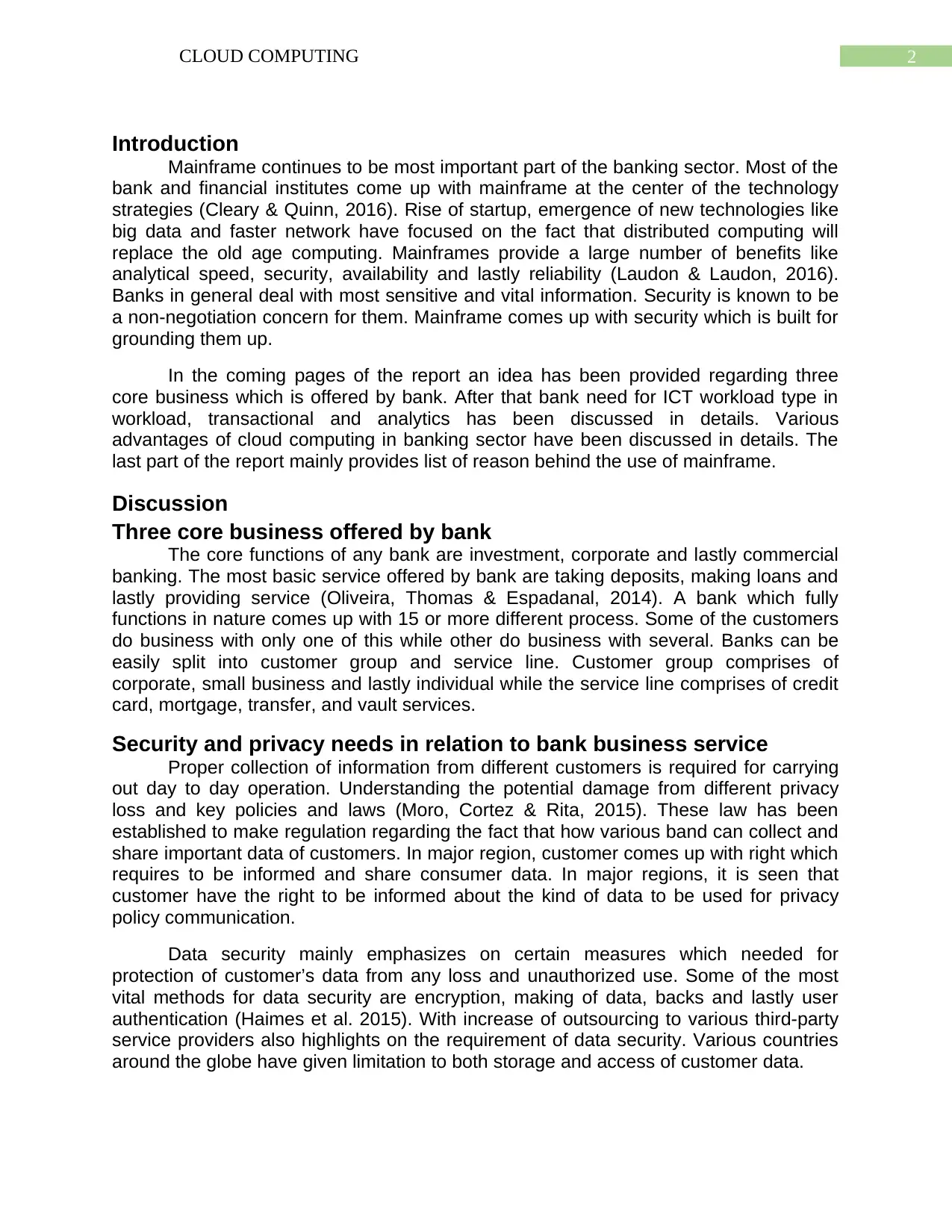
2CLOUD COMPUTING
Introduction
Mainframe continues to be most important part of the banking sector. Most of the
bank and financial institutes come up with mainframe at the center of the technology
strategies (Cleary & Quinn, 2016). Rise of startup, emergence of new technologies like
big data and faster network have focused on the fact that distributed computing will
replace the old age computing. Mainframes provide a large number of benefits like
analytical speed, security, availability and lastly reliability (Laudon & Laudon, 2016).
Banks in general deal with most sensitive and vital information. Security is known to be
a non-negotiation concern for them. Mainframe comes up with security which is built for
grounding them up.
In the coming pages of the report an idea has been provided regarding three
core business which is offered by bank. After that bank need for ICT workload type in
workload, transactional and analytics has been discussed in details. Various
advantages of cloud computing in banking sector have been discussed in details. The
last part of the report mainly provides list of reason behind the use of mainframe.
Discussion
Three core business offered by bank
The core functions of any bank are investment, corporate and lastly commercial
banking. The most basic service offered by bank are taking deposits, making loans and
lastly providing service (Oliveira, Thomas & Espadanal, 2014). A bank which fully
functions in nature comes up with 15 or more different process. Some of the customers
do business with only one of this while other do business with several. Banks can be
easily split into customer group and service line. Customer group comprises of
corporate, small business and lastly individual while the service line comprises of credit
card, mortgage, transfer, and vault services.
Security and privacy needs in relation to bank business service
Proper collection of information from different customers is required for carrying
out day to day operation. Understanding the potential damage from different privacy
loss and key policies and laws (Moro, Cortez & Rita, 2015). These law has been
established to make regulation regarding the fact that how various band can collect and
share important data of customers. In major region, customer comes up with right which
requires to be informed and share consumer data. In major regions, it is seen that
customer have the right to be informed about the kind of data to be used for privacy
policy communication.
Data security mainly emphasizes on certain measures which needed for
protection of customer’s data from any loss and unauthorized use. Some of the most
vital methods for data security are encryption, making of data, backs and lastly user
authentication (Haimes et al. 2015). With increase of outsourcing to various third-party
service providers also highlights on the requirement of data security. Various countries
around the globe have given limitation to both storage and access of customer data.
Introduction
Mainframe continues to be most important part of the banking sector. Most of the
bank and financial institutes come up with mainframe at the center of the technology
strategies (Cleary & Quinn, 2016). Rise of startup, emergence of new technologies like
big data and faster network have focused on the fact that distributed computing will
replace the old age computing. Mainframes provide a large number of benefits like
analytical speed, security, availability and lastly reliability (Laudon & Laudon, 2016).
Banks in general deal with most sensitive and vital information. Security is known to be
a non-negotiation concern for them. Mainframe comes up with security which is built for
grounding them up.
In the coming pages of the report an idea has been provided regarding three
core business which is offered by bank. After that bank need for ICT workload type in
workload, transactional and analytics has been discussed in details. Various
advantages of cloud computing in banking sector have been discussed in details. The
last part of the report mainly provides list of reason behind the use of mainframe.
Discussion
Three core business offered by bank
The core functions of any bank are investment, corporate and lastly commercial
banking. The most basic service offered by bank are taking deposits, making loans and
lastly providing service (Oliveira, Thomas & Espadanal, 2014). A bank which fully
functions in nature comes up with 15 or more different process. Some of the customers
do business with only one of this while other do business with several. Banks can be
easily split into customer group and service line. Customer group comprises of
corporate, small business and lastly individual while the service line comprises of credit
card, mortgage, transfer, and vault services.
Security and privacy needs in relation to bank business service
Proper collection of information from different customers is required for carrying
out day to day operation. Understanding the potential damage from different privacy
loss and key policies and laws (Moro, Cortez & Rita, 2015). These law has been
established to make regulation regarding the fact that how various band can collect and
share important data of customers. In major region, customer comes up with right which
requires to be informed and share consumer data. In major regions, it is seen that
customer have the right to be informed about the kind of data to be used for privacy
policy communication.
Data security mainly emphasizes on certain measures which needed for
protection of customer’s data from any loss and unauthorized use. Some of the most
vital methods for data security are encryption, making of data, backs and lastly user
authentication (Haimes et al. 2015). With increase of outsourcing to various third-party
service providers also highlights on the requirement of data security. Various countries
around the globe have given limitation to both storage and access of customer data.
⊘ This is a preview!⊘
Do you want full access?
Subscribe today to unlock all pages.

Trusted by 1+ million students worldwide
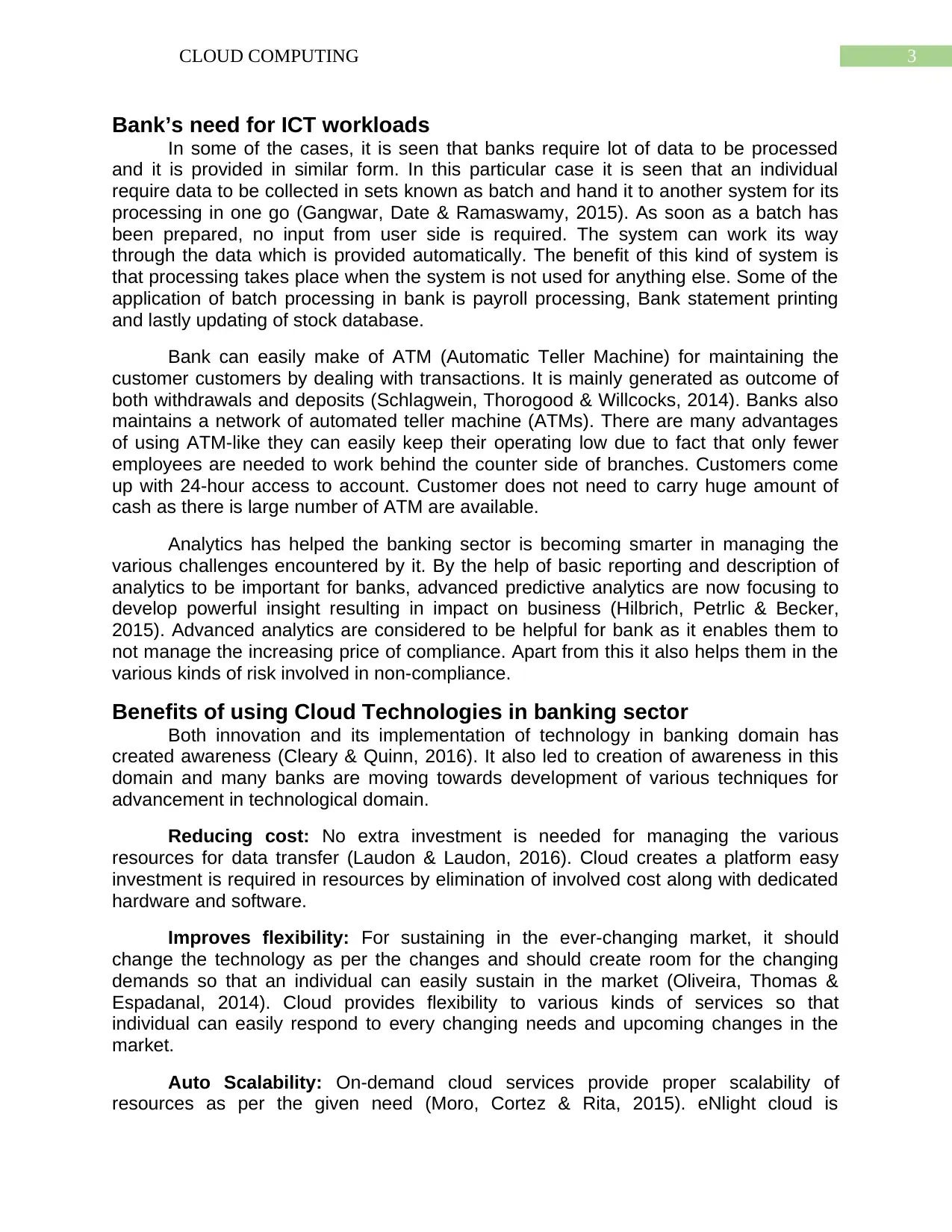
3CLOUD COMPUTING
Bank’s need for ICT workloads
In some of the cases, it is seen that banks require lot of data to be processed
and it is provided in similar form. In this particular case it is seen that an individual
require data to be collected in sets known as batch and hand it to another system for its
processing in one go (Gangwar, Date & Ramaswamy, 2015). As soon as a batch has
been prepared, no input from user side is required. The system can work its way
through the data which is provided automatically. The benefit of this kind of system is
that processing takes place when the system is not used for anything else. Some of the
application of batch processing in bank is payroll processing, Bank statement printing
and lastly updating of stock database.
Bank can easily make of ATM (Automatic Teller Machine) for maintaining the
customer customers by dealing with transactions. It is mainly generated as outcome of
both withdrawals and deposits (Schlagwein, Thorogood & Willcocks, 2014). Banks also
maintains a network of automated teller machine (ATMs). There are many advantages
of using ATM-like they can easily keep their operating low due to fact that only fewer
employees are needed to work behind the counter side of branches. Customers come
up with 24-hour access to account. Customer does not need to carry huge amount of
cash as there is large number of ATM are available.
Analytics has helped the banking sector is becoming smarter in managing the
various challenges encountered by it. By the help of basic reporting and description of
analytics to be important for banks, advanced predictive analytics are now focusing to
develop powerful insight resulting in impact on business (Hilbrich, Petrlic & Becker,
2015). Advanced analytics are considered to be helpful for bank as it enables them to
not manage the increasing price of compliance. Apart from this it also helps them in the
various kinds of risk involved in non-compliance.
Benefits of using Cloud Technologies in banking sector
Both innovation and its implementation of technology in banking domain has
created awareness (Cleary & Quinn, 2016). It also led to creation of awareness in this
domain and many banks are moving towards development of various techniques for
advancement in technological domain.
Reducing cost: No extra investment is needed for managing the various
resources for data transfer (Laudon & Laudon, 2016). Cloud creates a platform easy
investment is required in resources by elimination of involved cost along with dedicated
hardware and software.
Improves flexibility: For sustaining in the ever-changing market, it should
change the technology as per the changes and should create room for the changing
demands so that an individual can easily sustain in the market (Oliveira, Thomas &
Espadanal, 2014). Cloud provides flexibility to various kinds of services so that
individual can easily respond to every changing needs and upcoming changes in the
market.
Auto Scalability: On-demand cloud services provide proper scalability of
resources as per the given need (Moro, Cortez & Rita, 2015). eNlight cloud is
Bank’s need for ICT workloads
In some of the cases, it is seen that banks require lot of data to be processed
and it is provided in similar form. In this particular case it is seen that an individual
require data to be collected in sets known as batch and hand it to another system for its
processing in one go (Gangwar, Date & Ramaswamy, 2015). As soon as a batch has
been prepared, no input from user side is required. The system can work its way
through the data which is provided automatically. The benefit of this kind of system is
that processing takes place when the system is not used for anything else. Some of the
application of batch processing in bank is payroll processing, Bank statement printing
and lastly updating of stock database.
Bank can easily make of ATM (Automatic Teller Machine) for maintaining the
customer customers by dealing with transactions. It is mainly generated as outcome of
both withdrawals and deposits (Schlagwein, Thorogood & Willcocks, 2014). Banks also
maintains a network of automated teller machine (ATMs). There are many advantages
of using ATM-like they can easily keep their operating low due to fact that only fewer
employees are needed to work behind the counter side of branches. Customers come
up with 24-hour access to account. Customer does not need to carry huge amount of
cash as there is large number of ATM are available.
Analytics has helped the banking sector is becoming smarter in managing the
various challenges encountered by it. By the help of basic reporting and description of
analytics to be important for banks, advanced predictive analytics are now focusing to
develop powerful insight resulting in impact on business (Hilbrich, Petrlic & Becker,
2015). Advanced analytics are considered to be helpful for bank as it enables them to
not manage the increasing price of compliance. Apart from this it also helps them in the
various kinds of risk involved in non-compliance.
Benefits of using Cloud Technologies in banking sector
Both innovation and its implementation of technology in banking domain has
created awareness (Cleary & Quinn, 2016). It also led to creation of awareness in this
domain and many banks are moving towards development of various techniques for
advancement in technological domain.
Reducing cost: No extra investment is needed for managing the various
resources for data transfer (Laudon & Laudon, 2016). Cloud creates a platform easy
investment is required in resources by elimination of involved cost along with dedicated
hardware and software.
Improves flexibility: For sustaining in the ever-changing market, it should
change the technology as per the changes and should create room for the changing
demands so that an individual can easily sustain in the market (Oliveira, Thomas &
Espadanal, 2014). Cloud provides flexibility to various kinds of services so that
individual can easily respond to every changing needs and upcoming changes in the
market.
Auto Scalability: On-demand cloud services provide proper scalability of
resources as per the given need (Moro, Cortez & Rita, 2015). eNlight cloud is
Paraphrase This Document
Need a fresh take? Get an instant paraphrase of this document with our AI Paraphraser
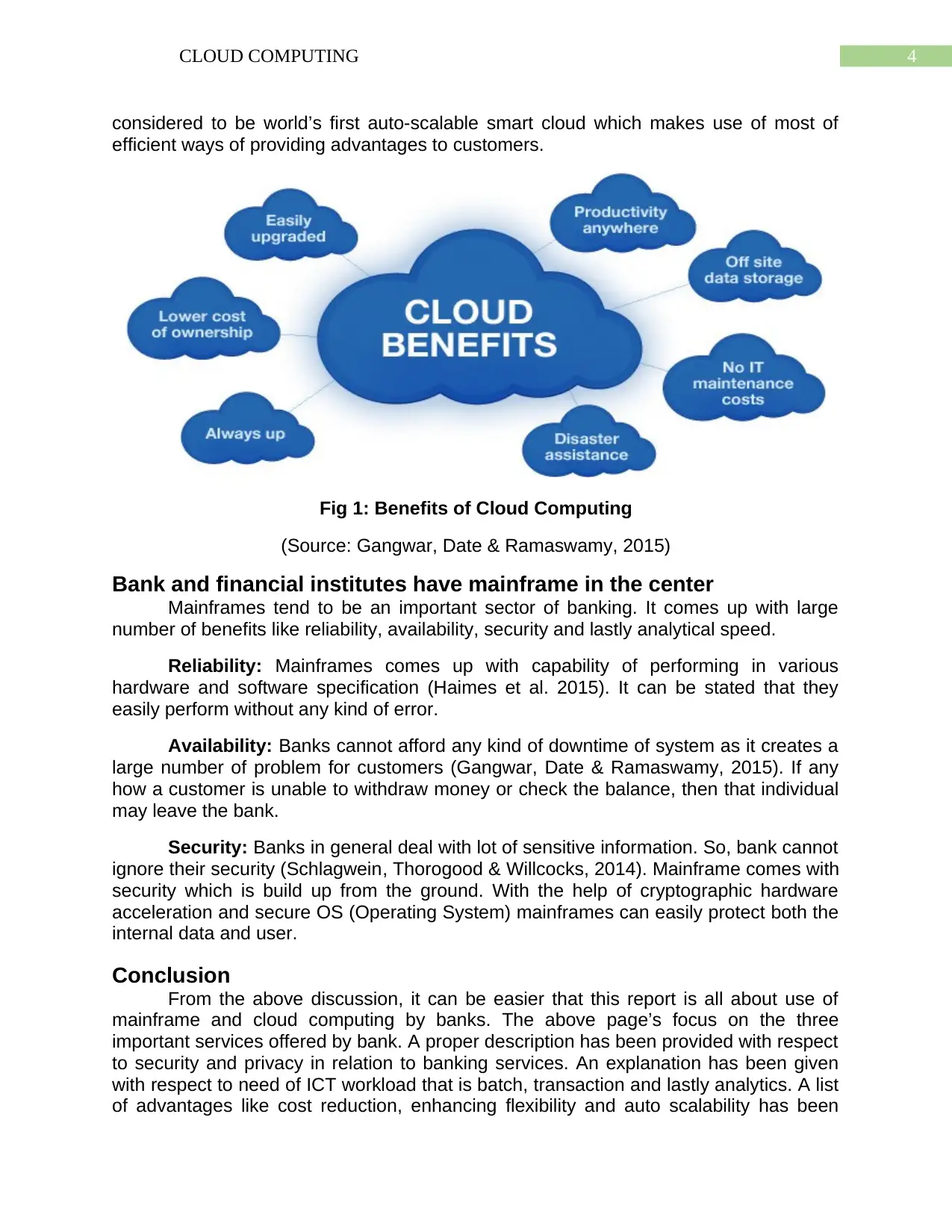
4CLOUD COMPUTING
considered to be world’s first auto-scalable smart cloud which makes use of most of
efficient ways of providing advantages to customers.
Fig 1: Benefits of Cloud Computing
(Source: Gangwar, Date & Ramaswamy, 2015)
Bank and financial institutes have mainframe in the center
Mainframes tend to be an important sector of banking. It comes up with large
number of benefits like reliability, availability, security and lastly analytical speed.
Reliability: Mainframes comes up with capability of performing in various
hardware and software specification (Haimes et al. 2015). It can be stated that they
easily perform without any kind of error.
Availability: Banks cannot afford any kind of downtime of system as it creates a
large number of problem for customers (Gangwar, Date & Ramaswamy, 2015). If any
how a customer is unable to withdraw money or check the balance, then that individual
may leave the bank.
Security: Banks in general deal with lot of sensitive information. So, bank cannot
ignore their security (Schlagwein, Thorogood & Willcocks, 2014). Mainframe comes with
security which is build up from the ground. With the help of cryptographic hardware
acceleration and secure OS (Operating System) mainframes can easily protect both the
internal data and user.
Conclusion
From the above discussion, it can be easier that this report is all about use of
mainframe and cloud computing by banks. The above page’s focus on the three
important services offered by bank. A proper description has been provided with respect
to security and privacy in relation to banking services. An explanation has been given
with respect to need of ICT workload that is batch, transaction and lastly analytics. A list
of advantages like cost reduction, enhancing flexibility and auto scalability has been
considered to be world’s first auto-scalable smart cloud which makes use of most of
efficient ways of providing advantages to customers.
Fig 1: Benefits of Cloud Computing
(Source: Gangwar, Date & Ramaswamy, 2015)
Bank and financial institutes have mainframe in the center
Mainframes tend to be an important sector of banking. It comes up with large
number of benefits like reliability, availability, security and lastly analytical speed.
Reliability: Mainframes comes up with capability of performing in various
hardware and software specification (Haimes et al. 2015). It can be stated that they
easily perform without any kind of error.
Availability: Banks cannot afford any kind of downtime of system as it creates a
large number of problem for customers (Gangwar, Date & Ramaswamy, 2015). If any
how a customer is unable to withdraw money or check the balance, then that individual
may leave the bank.
Security: Banks in general deal with lot of sensitive information. So, bank cannot
ignore their security (Schlagwein, Thorogood & Willcocks, 2014). Mainframe comes with
security which is build up from the ground. With the help of cryptographic hardware
acceleration and secure OS (Operating System) mainframes can easily protect both the
internal data and user.
Conclusion
From the above discussion, it can be easier that this report is all about use of
mainframe and cloud computing by banks. The above page’s focus on the three
important services offered by bank. A proper description has been provided with respect
to security and privacy in relation to banking services. An explanation has been given
with respect to need of ICT workload that is batch, transaction and lastly analytics. A list
of advantages like cost reduction, enhancing flexibility and auto scalability has been

5CLOUD COMPUTING
discussed in details. The last section of report mainly deals with use of mainframes in
banks.
discussed in details. The last section of report mainly deals with use of mainframes in
banks.
⊘ This is a preview!⊘
Do you want full access?
Subscribe today to unlock all pages.

Trusted by 1+ million students worldwide
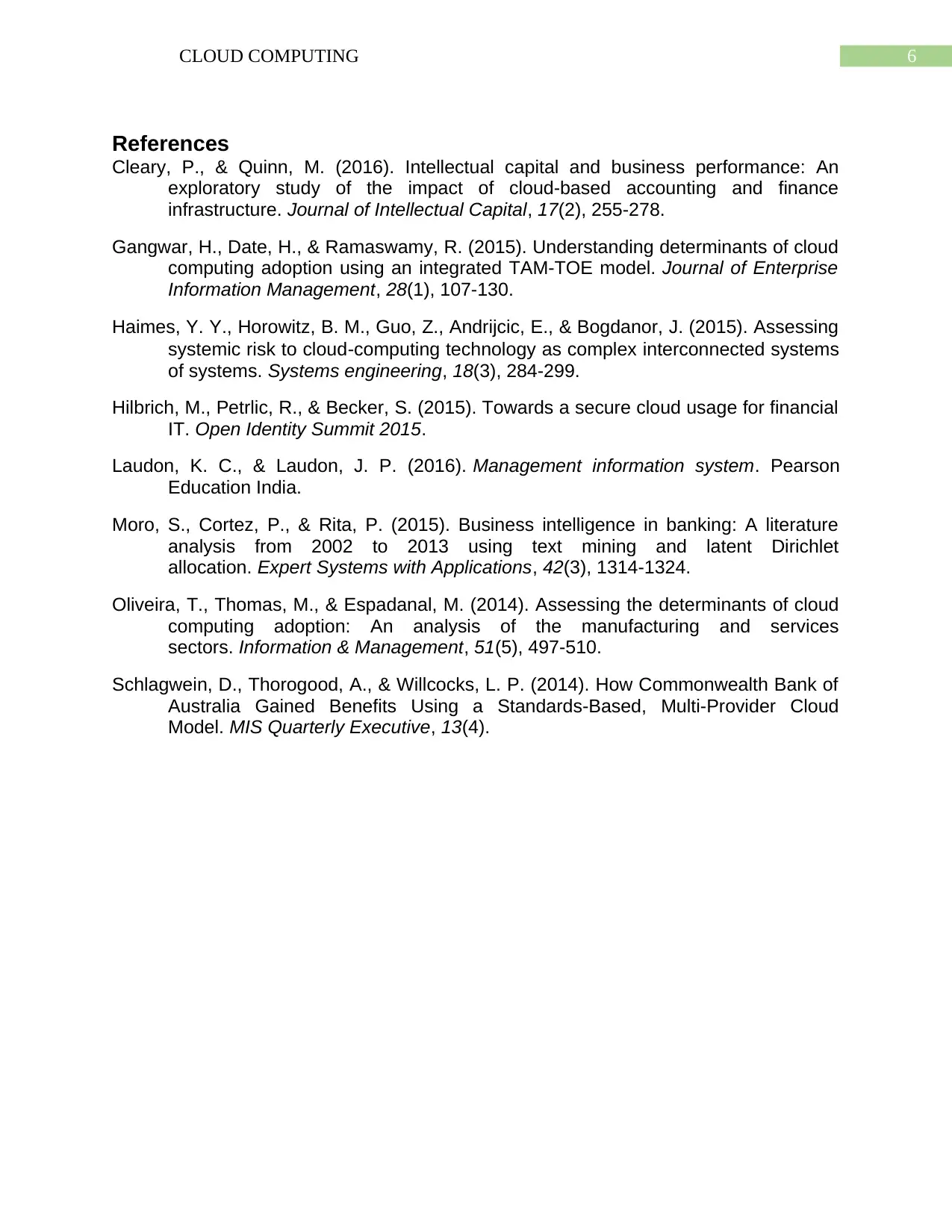
6CLOUD COMPUTING
References
Cleary, P., & Quinn, M. (2016). Intellectual capital and business performance: An
exploratory study of the impact of cloud-based accounting and finance
infrastructure. Journal of Intellectual Capital, 17(2), 255-278.
Gangwar, H., Date, H., & Ramaswamy, R. (2015). Understanding determinants of cloud
computing adoption using an integrated TAM-TOE model. Journal of Enterprise
Information Management, 28(1), 107-130.
Haimes, Y. Y., Horowitz, B. M., Guo, Z., Andrijcic, E., & Bogdanor, J. (2015). Assessing
systemic risk to cloud‐computing technology as complex interconnected systems
of systems. Systems engineering, 18(3), 284-299.
Hilbrich, M., Petrlic, R., & Becker, S. (2015). Towards a secure cloud usage for financial
IT. Open Identity Summit 2015.
Laudon, K. C., & Laudon, J. P. (2016). Management information system. Pearson
Education India.
Moro, S., Cortez, P., & Rita, P. (2015). Business intelligence in banking: A literature
analysis from 2002 to 2013 using text mining and latent Dirichlet
allocation. Expert Systems with Applications, 42(3), 1314-1324.
Oliveira, T., Thomas, M., & Espadanal, M. (2014). Assessing the determinants of cloud
computing adoption: An analysis of the manufacturing and services
sectors. Information & Management, 51(5), 497-510.
Schlagwein, D., Thorogood, A., & Willcocks, L. P. (2014). How Commonwealth Bank of
Australia Gained Benefits Using a Standards-Based, Multi-Provider Cloud
Model. MIS Quarterly Executive, 13(4).
References
Cleary, P., & Quinn, M. (2016). Intellectual capital and business performance: An
exploratory study of the impact of cloud-based accounting and finance
infrastructure. Journal of Intellectual Capital, 17(2), 255-278.
Gangwar, H., Date, H., & Ramaswamy, R. (2015). Understanding determinants of cloud
computing adoption using an integrated TAM-TOE model. Journal of Enterprise
Information Management, 28(1), 107-130.
Haimes, Y. Y., Horowitz, B. M., Guo, Z., Andrijcic, E., & Bogdanor, J. (2015). Assessing
systemic risk to cloud‐computing technology as complex interconnected systems
of systems. Systems engineering, 18(3), 284-299.
Hilbrich, M., Petrlic, R., & Becker, S. (2015). Towards a secure cloud usage for financial
IT. Open Identity Summit 2015.
Laudon, K. C., & Laudon, J. P. (2016). Management information system. Pearson
Education India.
Moro, S., Cortez, P., & Rita, P. (2015). Business intelligence in banking: A literature
analysis from 2002 to 2013 using text mining and latent Dirichlet
allocation. Expert Systems with Applications, 42(3), 1314-1324.
Oliveira, T., Thomas, M., & Espadanal, M. (2014). Assessing the determinants of cloud
computing adoption: An analysis of the manufacturing and services
sectors. Information & Management, 51(5), 497-510.
Schlagwein, D., Thorogood, A., & Willcocks, L. P. (2014). How Commonwealth Bank of
Australia Gained Benefits Using a Standards-Based, Multi-Provider Cloud
Model. MIS Quarterly Executive, 13(4).
1 out of 7
Related Documents
Your All-in-One AI-Powered Toolkit for Academic Success.
+13062052269
info@desklib.com
Available 24*7 on WhatsApp / Email
![[object Object]](/_next/static/media/star-bottom.7253800d.svg)
Unlock your academic potential
Copyright © 2020–2025 A2Z Services. All Rights Reserved. Developed and managed by ZUCOL.





